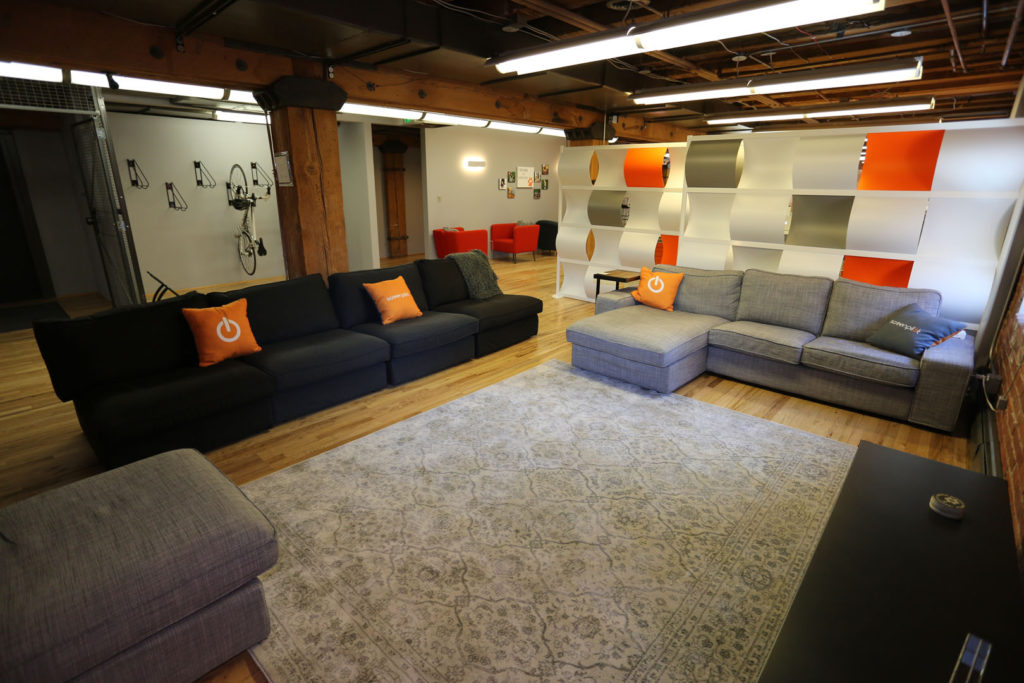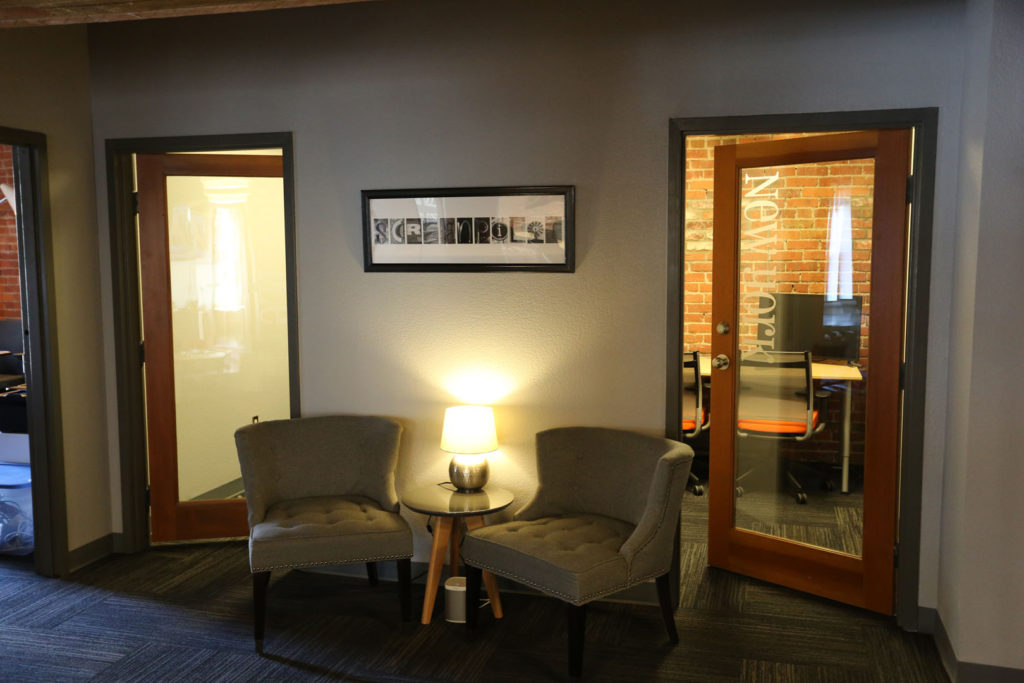7 Strategies for a Successful Office Renovation
by Audrey Wilson



Sixth Avenue West – Golden, Colorado
Often referred to as tenant improvements, office renovations provide an opportunity to care for your employees while optimizing for greater efficiency and sustainability in both work systems and energy use. Tenant improvement projects are often triggered upon signing a new office lease. In addition to upgraded finishes, health-conscious amenities, and flexible workspace plans, we’ve seen that the best remodels create a place where employees’ mental, physical, and socioemotional wellbeing is considered. This thinking isn’t new. Big technology companies like Google are known for their innovative, employee-centered spaces. And Steelcase, a global office furniture and interior design firm, has extensively studied the impact workplace environment can have on employee engagement. With the potential for happy and healthy employees, less turnover, increased efficiency, and long-term cost savings, what do you have to lose?
Even with all of the benefits, the reality of construction lead times, potential business disruption, and project complexity can make any tenant improvement process feel daunting. And poorly managed renovations can cost major time and money. It doesn’t have to be that way! We talked with building owners, brokers, property managers, and designers to uncover the most common pitfalls we see time and time again and created some strategies to help you avoid them.
Common Renovation Obstacles:
- Hiring a non-reputable team
- Poorly designed plans
- Scope creep
- Overspending
- Stretched timelines
- Employee dissatisfaction
- Not considering sustainable design
Don’t fret! Taken holistically, the following tips will help you plan for success:
Strategy 1: Engage the Right Partners Early
“Experience and reputation are the most important factors in selecting general contractors and architects,” says Joe Lamkin, principal at Bancroft Capital. Poor quality partners can make mistakes that cost time and money. Start by asking your broker and/or building owner for general contractor and architect references. Research their previous work and ask people you trust about their reputability.
You’ll want a team invested in your success, rather than a mill. Find partners who understand the importance of communication, who anticipates your needs, and are thoughtful regarding all of your stakeholders. Once you’ve built your team, involve them early! General contractors are great for supporting owners on budget, timeline, and overall design feasibility.
Strategy 2: Develop a Solid Initial Design
Beyond the noticeable finish selections like paint color, flooring materials, and wood varietals, you want the mechanical, electrical, and plumbing (MEP) drawings and aesthetic components to be code compliant. Older buildings generally need upgraded ADA elements and the MEP programming will be more complex. Your architect is the expert in this area and should ensure the plans are sound before providing the official stamp of approval. When you have stamped drawings in your hand, the last thing you need is a mishap in the permitting process. Every redraw or code compliance issue could add another 1-2 weeks to your construction start date! Lastly, great contract drawings make the bidding process easier and more accurate so you can feel confident in the estimates.
Strategy 3: Clear Delegation & Responsibility
Scope creep can happen when elements have not been fully designed or project details are left undefined. When the scope of work is unclear, subcontractors may avoid responsibility or sometimes double up the work to protect themselves contractually. The best remedy? A strong team from the start. Really good design and construction professionals know to identify and delegate scope responsibility to avoid miscommunication, overwork, and overpaying.
Strategy 4: Budget Realistically and Plan for Contingency
“Many times clients do not allow enough budget for what has been designed and then end up making sacrifices regarding overall quality and durability or timeline,” says Rich Snyder, owner of Snyder Building Construction. For a mid-level commercial upgrade in Denver, be prepared to spend $45-$55 per square foot for construction. In addition to this amount, ensure you’re thoroughly considering the design and engineering processes for your basic trades (mechanical, electrical, and plumbing). A word to the wise, these estimated numbers do not include furniture and fixtures! And of course, actual cost will vary based on your individual project.
More importantly, plan a 5% contingency cost line into your budget. The industry is busy, and unforeseen field conditions are not uncommon. Plan ahead for this and you’ll have a better sense of actual costs for your renovation.
Strategy 5: Plan Ahead to Stay on Time
Do the preparation work to develop strong drawings. Gauge lead times for permitting, material delivery, and contractor mobilization appropriately. Every vendor and supplier is different. We’ve listed a few of our known long-leads based on trends here in Denver. Michelle Miller, licensed architect and principal of Jigsaw Design, noted you should expect timelines of about 10-12 weeks from the beginning of schematic design with the architect to the start of construction. Great general contractors are ahead of the game and develop schedules that are well versed in the lead times for their geographical area.
In Denver, expect 5 to 6 weeks for the design process and the architectural, MEP, and construction drawings to be completed. Add another 5 to 6 weeks for general contractor bidding and contracting. You can also expect typical long-lead items like decorative lighting and commercial furniture to run 8 to 12 weeks and 8 to 10 weeks respectively. These timelines are just a guide, but hopefully provide some insight into the scheduling components that need consideration.
Strategy 6: Get Employee Buy-In
If you’re moving into a new space, and the tenant improvement process is part of the initial lease agreement, the construction phases may be less of a disturbance to your team. Otherwise, if your team is currently occupying the space you plan to renovate, there are certainly things to consider. Will the team work remotely during the construction? Would you prefer to complete construction in sections and keep employees onsite? The general contractor can be an incredible guide in making these decisions as they are the most knowledgeable in terms of lead times, construction planning, potential noise, and disruption.
While the end result is anticipated to please your team, the moving process and relocation can be very disruptive to tenants. If the new space is underwhelming, it could have an opposite effect on company morale. “Team members and building tenants can become quick adversaries if construction noise, dust, and other nuisances become overwhelming,” says Lamkin. Consider involving your team in the early visioning process. Dialogue and surveys can provide insight to what your employees are really looking for. Professional space planners are also available for hire and can help with understanding what your employees are looking for.
Lastly, choose partners who will go the extra mile to inform about the construction process and who are proactive in their approach. Some ways we do this at Snyder Building Construction include: keeping highly disruptive work after hours or on weekends; keeping the work areas clean; using negative air fans with air filters; providing clear notification of construction areas; as well as keeping flow open and not blocking tenant access.
Strategy 7: Consider Sustainability and Health
We partnered with Bancroft Capital to study 51 possible sustainable upgrades for a tenant. Of those 51, we found three that provided good economical and environmental benefits⎼a huge win for the tenant and the owner. These three upgrades included: solatubes used in conjunction with advanced day-lighting controls, and ultra energy-efficient HVAC units. Consider looking into these options for your project as well.
Holistic health encourages physical, mental, and emotional wellness. We’ve seen success supporting employee health through bike storage, prominent staircases, standing desks, water bottle refill stations, and healthy snack vending.
BONUS Strategy
Quality, Time, and Cost⏤all three are in play, but you can only pick two.
This is age-old, industry wisdom. In almost all cases, owners want the highest quality products and performance while sticking to stringent budgets and timelines. The best general contractors, designers, and architects already know this and have your best interest in mind regarding all three. However, no matter how much planning goes into a project, you’ll want to know which two of these priorities mean the most to you. “The stakeholders (owner, tenant, and general contractor) must have a firm grasp on the desired outcome and the driving economic factors of the project,” says Lamkin. Together, your team serves as checks and balances to make sure all project elements are prioritized appropriately.
Want to learn more about how Snyder Building Construction can support your tenant improvement project? Contact us! We provide commercial and multi-family residential estimating, preconstruction, and full general contracting services in and around Denver. Special thanks to our contributors Bancroft Capital and Jigsaw Design, LLC. Audrey Wilson is an Assistant Project Manager with Snyder Building Construction.








Recent Comments